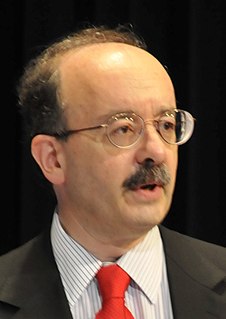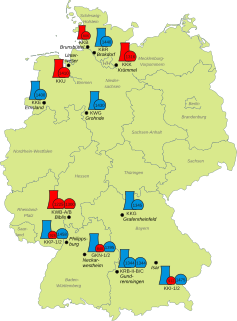
Electricity generation is the process of generating electric power from sources of primary energy. For utilities in the electric power industry, it is the stage prior to its delivery to end users or its storage.

Nuclear power is the use of nuclear reactions that release nuclear energy to generate heat, which most frequently is then used in steam turbines to produce electricity in a nuclear power plant. Nuclear power can be obtained from nuclear fission, nuclear decay and nuclear fusion reactions. Presently, the vast majority of electricity from nuclear power is produced by nuclear fission of uranium and plutonium. Nuclear decay processes are used in niche applications such as radioisotope thermoelectric generators. Generating electricity from fusion power remains at the focus of international research. This article mostly deals with nuclear fission power for electricity generation.

A nuclear power plant is a thermal power station in which the heat source is a nuclear reactor. As is typical of thermal power stations, heat is used to generate steam that drives a steam turbine connected to a generator that produces electricity. As of 2018, the International Atomic Energy Agency reported there were 450 nuclear power reactors in operation in 30 countries.

Amory Bloch Lovins is an American writer, physicist, and Chairman/Chief Scientist of the Rocky Mountain Institute. He has written on energy policy and related areas for four decades, and served on the National Petroleum Council, an oil industry lobbying group, from 2011–2018. In 1983, Lovins was awarded the Right Livelihood Award for "pioneering soft energy paths for global security." He was named by TIME magazine one of the World's 100 most influential people in 2009.

India is the world's third largest producer and third largest consumer of electricity. The national electric grid in India has an installed capacity of 373.436 GW as of 31 October 2020. Renewable power plants, which also include large hydroelectric plants, constitute 36.17% of India's total installed capacity. During the 2018-19 fiscal year, the gross electricity generated by utilities in India was 1,372 TWh and the total electricity generation in the country was 1,547 TWh. The gross electricity consumption in 2018-19 was 1,181 kWh per capita. In 2015-16, electric energy consumption in agriculture was recorded as being the highest (17.89%) worldwide. The per capita electricity consumption is low compared to most other countries despite India having a low electricity tariff.

A fossil fuel power station is a thermal power station which burns a fossil fuel, such as coal or natural gas, to produce electricity. Fossil fuel power stations have machinery to convert the heat energy of combustion into mechanical energy, which then operates an electrical generator. The prime mover may be a steam turbine, a gas turbine or, in small plants, a reciprocating gas engine. All plants use the energy extracted from expanding gas, either steam or combustion gases. Although different energy conversion methods exist, all thermal power station conversion methods have efficiency limited by the Carnot efficiency and therefore produce waste heat.

A nuclear power phase-out is the discontinuation of usage of nuclear power for energy production. Often initiated because of concerns about nuclear power, phase-outs usually include shutting down nuclear power plants and looking towards fossil fuels and renewable energy. Three nuclear accidents have influenced the discontinuation of nuclear power: the 1979 Three Mile Island partial nuclear meltdown in the United States, the 1986 Chernobyl disaster in the USSR, and the 2011 Fukushima nuclear disaster in Japan.

Nuclear power in the United States is provided by 95 commercial reactors with a net capacity of 98 gigawatts (GW), 64 pressurized water reactors and 32 boiling water reactors. In 2019 they produced a total of 809.41 terawatt hours of electricity, which accounted for 20% of the nation's total electric energy generation. In 2018, nuclear energy comprised nearly 50 percent of U.S. emission-free generation.

Taiwan relies on imports for almost 98% of its energy in 2016, which leaves the island's energy supply vulnerable to external disruption. In order to reduce this dependence, the Ministry of Economic Affairs' Bureau of Energy has been actively promoting energy research at several universities since the 1990s.
An integrated gasification combined cycle (IGCC) is a technology that uses a high pressure gasifier to turn coal and other carbon based fuels into pressurized gas—synthesis gas (syngas). It can then remove impurities from the syngas prior to the power generation cycle. Some of these pollutants, such as sulfur, can be turned into re-usable byproducts through the Claus process. This results in lower emissions of sulfur dioxide, particulates, mercury, and in some cases carbon dioxide. With additional process equipment, a water-gas shift reaction can increase gasification efficiency and reduce carbon monoxide emissions by converting it to carbon dioxide. The resulting carbon dioxide from the shift reaction can be separated, compressed, and stored through sequestration. Excess heat from the primary combustion and syngas fired generation is then passed to a steam cycle, similar to a combined cycle gas turbine. This process results in improved thermodynamic efficiency compared to conventional pulverized coal combustion.
The energy policy of India is largely defined by the country's expanding energy deficit and increased focus on developing alternative sources of energy, particularly nuclear, solar and wind energy. India attained 63% overall energy self-sufficiency in 2017.

Renewable energy commercialization involves the deployment of three generations of renewable energy technologies dating back more than 100 years. First-generation technologies, which are already mature and economically competitive, include biomass, hydroelectricity, geothermal power and heat. Second-generation technologies are market-ready and are being deployed at the present time; they include solar heating, photovoltaics, wind power, solar thermal power stations, and modern forms of bioenergy. Third-generation technologies require continued R&D efforts in order to make large contributions on a global scale and include advanced biomass gasification, hot-dry-rock geothermal power, and ocean energy. As of 2012, renewable energy accounts for about half of new nameplate electrical capacity installed and costs are continuing to fall.

New nuclear power plants typically have high capital expenditure for building the plant. Fuel, operational, and maintenance costs are relatively small components of the total cost. The long service life and high capacity factor of nuclear power plants allow sufficient funds for ultimate plant decommissioning and waste storage and management to be accumulated, with little impact on the price per unit of electricity generated. Other groups disagree with these statements. Additionally, measures to mitigate climate change such as a carbon tax or carbon emissions trading, would favor the economics of nuclear power over fossil fuel power. Other groups argue that nuclear power is not the answer to climate change.
Peter A. Bradford is a former member of the U.S. Nuclear Regulatory Commission who teaches energy policy and law at the Vermont Law School. He is the author of Fragile Structures: A Story of Oil Refineries, National Security and the Coast of Maine and has written many articles. He served on various advisory panels and expert groups relating to nuclear power. He participated in a 1968 Ralph Nader-sponsored study of the Federal Trade Commission. Bradford has a law degree from Yale Law School.
The Levy County Nuclear Power Plant was a proposed nuclear power plant in Levy County, Florida. Progress Energy Florida originally estimated that the reactors would cost $5 billion and would commence operation in 2016. But it later became clear that the Levy County reactors would not have started operation until at least 2026, if ever. Since Progress filed its application for the new plant in 2008 demand for electricity has been growing very slowly, and natural gas prices are now extremely low. The utility now estimates that the reactors will cost between $17 billion and $22 billion, not counting financing charges and cost overruns. According to economist Mark Cooper, opposition to the project has mounted, threatening a rerun of the 1970s and 1980s, when the majority of nuclear construction plans were canceled or abandoned.
Natural gas was the Canada's third largest source of energy production in 2018, representing 22.3% of all energy produced from fuels in the country. By contrast, the share of fuel-based energy production from natural gas in 2013 was 17.0%, indicating a growth rate of approximately 1.06% per year.

The nuclear power debate is a long-running controversy about the risks and benefits of using nuclear reactors to generate electricity for civilian purposes. The debate about nuclear power peaked during the 1970s and 1980s, as more and more reactors were built and came online, and "reached an intensity unprecedented in the history of technology controversies" in some countries. Thereafter, the nuclear industry created jobs, focused on safety, and public concerns mostly waned. In the last decade, however, with growing public awareness about climate change and the critical role that carbon dioxide and methane emissions plays in causing the heating of the earth's atmosphere, there has been a resurgence in the intensity of the nuclear power debate. Nuclear power advocates and those most concerned about climate change point to nuclear power's reliable, emission-free, high-density energy, alongside a generation of young physicists and engineers working to bring a new generation of nuclear technology into existence to replace fossil fuels. On the other hand, skeptics point to nuclear accidents such as the death of Louis Slotin, the Windscale fire, the Three Mile Island accident, the Chernobyl disaster, and the Fukushima Daiichi nuclear disaster, combined with escalating acts of global terrorism, to argue against continuing use of the technology.

Between 2007 and 2009, 13 companies applied to the Nuclear Regulatory Commission for construction and operating licenses to build 31 new nuclear power reactors in the United States. However, the case for widespread nuclear plant construction has been hampered due to inexpensive natural gas, slow electricity demand growth in a weak US economy, lack of financing, and safety concerns following the Fukushima nuclear disaster in 2011.
Different methods of electricity generation can incur significantly different costs, and these costs can occur at significantly different times relative to when the power is used. Calculations of these costs can be made at the point of connection to a load or to the electricity grid, so that they may or may not include the transmission costs. The costs include the initial capital, and the costs of continuous operation, fuel, and maintenance as well as the costs of de-commissioning and remediating any environmental damage.

Turkey consumes over 6 exajoules of primary energy per year, over 20 megawatt hours (MW/h) per person, of which over 85% is fossil fuels. Energy policy includes reducing fossil fuel imports, which were over 20% of import costs in 2019, and three quarters of the current account deficit. In the three decades from 1990 annual primary energy supply tripled, and in 2019 included almost 30% oil, almost 30% coal, and about 25% gas.













